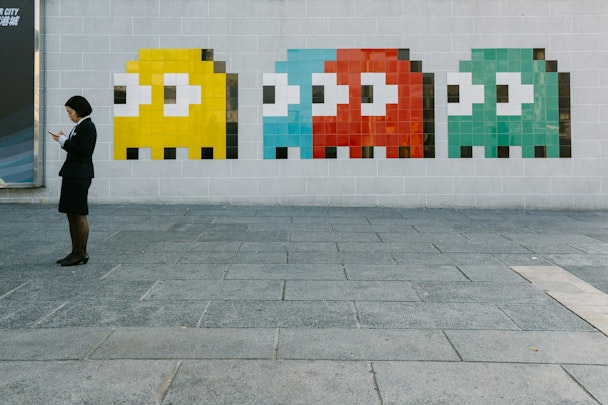Why the joys of real-world advertising still can’t be recreated by AI or screens
The Drum Network recently hosted a panel at agency Global Street Art’s unique gallery space in Shoreditch, London, to discuss the impact of great visuals in creative work – both in real life and on our screens.

Monumental pieces of art on walls are often the best way to capture people's attentions, the panel agreed. / Bady Abbas via Unsplash
From Maybelline sticking giant AR eyelashes to the front of tube trains in a viral example of ‘FOOH’ (fake out-of-home), to The Ordinary floating a gigantic model of their product down the River Thames, the takeaway from The Drum’s most recent panel on the power of visual culture in great creative was that even in an age defined by rapid technological change, the real world still is the best arena.
Reassuring, when it sometimes seems that AI and other technology might gobble up the creative industries whole. On AI in particular, Rae Stones, executive creative director at Oliver, says that she was “scared of it when I found it, not this January but last January... It was Christmas and I was like, ‘Holy fuck. Oh, fuck. Oh, fuck, fuck.’ And then I realized, actually, ‘Oh, it's okay. It's okay, I understand how I can use it to be better rather than replace what I'm trying to do.’”
Arjun Singh, global creative operations director at Team Lewis, allayed Stones’ fears. “A lot of what you guys are doing, there's a permanence around it,” he said. ”A lot of our clients actually still invest huge amounts of money into the permanence or the tangibility of what you do. There's a truth and it makes you believe that that thing is worth it and trustworthy and it feels like people have invested time and money into creating that thing. And it goes against the disposable Shein, Temu kind of world we live in.”
Lee Bofkin, cofounder and chief executive officer of Global Street Art, agrees. “That's the stuff where, floating it down the Thames - Burberry and other people have done it - does build your sense of scale and luxury. Because it's the ‘costly signaling’ that comes behind doing that. If the message costs more resources or expense to do, it's worth more. So the real world stuff you're doing is a proof point of a brand.”
Advertisement
The role of failure in creativity
According to our panel, there's a nuanced difference between (on the one hand) supporting the creative process and (on the other) simply managing creatives. “Often when we think of creativity, it's quite individual, there’s the idea that it's quite individualistic,” Bofkin said. “But it's worth talking about: the creative process that you have as an individual, but also how that marries up, or differs, from how you work with groups of creatives.”
For Stones, creativity is a lot about failure and the ability to take rejection. “I think the nature of creativity, especially in our industry, is failure,” she said. “Because probably 99% of my ideas over the course of my career have been rejected. And I've been told why they're terrible. And creativity to me is to still want to crack that brief to still have another idea.”
This same dynamic inspired Singh to identify the nature of the particular historical moment we live in. “We're at a crossroads at the moment about speed and value with clients,” Singh says. The opportunity to offer good work, fast, to clients thus motivates Singh, who added: “I love making money for clients. That's what we're here [to do].”
This leads to an age old advertising conundrum: how to price and bill creativity and its outputs. If an idea takes an hour to come up with and makes the client millions, should they still only be billed for an hour?
Advertisement
It's fine to reuse, as long as you refine
Stones was in the mood to spill industry secrets. “There's the 'seven year rule', which obviously we don’t talk about out loud, which I'm probably breaking every rule in the creative department by speaking about this,” she said. “It’s that if a campaign or an idea ran seven years ago, we’re fine to be inspired by it again.”
Stones adds that there's a difference between stealing and being inspired, pointing to a recent campaign from The Economist which rehashed a tagline previously used by competitor The Guardian.
Bofkin points out that often (as in the famous British recruitment propaganda from World War 2 with the strapline “Your Country Needs You”), familiarity resonates. But familiarity is one thing; plagiarism is quite another, especially in the context of generative AIs hoovering up vast datasets and spitting out executions based on those datasets.
“I think what offends us is when it's lazy or it's unrefined,” Bofkin suggests. “If you're going to take a good idea, it needs a spin, it needs lots of different spins, it needs to be taken, perhaps, beyond recognition.”
Reality is a beautiful place
This takes us full-circle, to the relative merits of OOH versus FOOH. Bofkin, whose business paints murals for businesses in public spaces, says he doesn’t feel too threatened by the rise of AR advertising superimposed onto the real world via mobile phone screens.
“The fact it's on a massive wall and you're outside on the phone, you're consuming the fake out of home thing, and you're just like...” Bofkin here mimes looking up from a phone screen to see a massive mural “...Oh no, that's so good. Not only am I impressed that humans did it. Yeah, and it's massive. I'm going to share it, they're going to share it.”
Still, advertising environments are increasingly noisy and competitive, so how can advertisers (whatever their medium) stand out in the battle for customers’ attention?
Stones says it's key to think about things in terms of their benefit to the consumer. “We have to interest them; we have to capture their imagination,” she says. “We can't talk about ourselves as a brand; we have to talk to them about what they're interested in... We have to talk about what the benefit is. The benefit of the benefit, almost. Like, what is the benefit to the consumer?”
You can watch the whole panel over on The Drum TV.
Suggested newsletters for you
Content created with:

Global Street Art
Global Street Art’s mission is “to Live in Painted Cities”. This is realised by working with top street artists, creating incredible murals for commercial...
Find out more
OLIVER
Our unique model moves at the speed of modern business to drive change from the inside out; working smarter to make our clients’ money go further, and helping...
Find out more
TEAM LEWIS
TEAM LEWIS is a global marketing agency, delivering Creative Campaigns for Commercial and Community Causes. The company has 25 offices throughout Asia, EMEA and...
Find out more
